 W
WAccording to the Encyclopedia of Camps and Ghettos, there were 23 main concentration camps, of which most had a system of satellite camps. Including the satellite camps, the total number of Nazi concentration camps that existed at one point in time is at least 1,000, although these did not all exist at the same time.
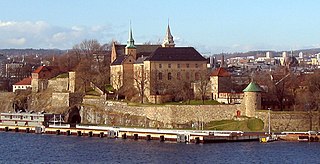 W
WAkershus Fortress or Akershus Castle is a medieval castle in the Norwegian capital Oslo that was built to protect and provide a royal residence for the city. Since the middle ages the fortress was the namesake and centre of the main fief and later main county of Akershus, which was originally one of Norway's four main regions and which included most of Eastern Norway. The fortress itself was located within Akershus main county until 1919, and also within the smaller Akershus sub county until 1842.
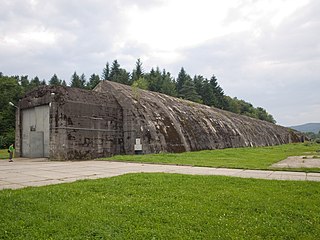 W
WAnlage Süd was a pair of railway headquarters built for Adolf Hitler in the Nazi-occupied part of southern Poland during the Second World War. Two reinforced tunnels were built near the rail line between Rzeszów and Jasło. The first massive train bunker was located in the village of Stępina, and the other was in the town of Strzyżów. They were initially used for a two-day meeting between Hitler and Italian fascist leader Benito Mussolini, on 27–28 August 1941.
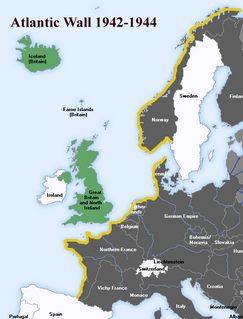 W
WThe Atlantic Wall was an extensive system of coastal defences and fortifications built by Nazi Germany between 1942 and 1944, along the coast of continental Europe and Scandinavia as a defence against an anticipated Allied invasion of Nazi-occupied Europe from the United Kingdom, during World War II. The manning and operation of the Atlantic Wall was administratively overseen by the German Army, with some support from Luftwaffe ground forces. The Kriegsmarine maintained a separate coastal defence network, organised into a number of sea defence zones.
 W
WThe Auschwitz concentration camp was a complex of over 40 concentration and extermination camps operated by Nazi Germany in occupied Poland during World War II and the Holocaust. It consisted of Auschwitz I, the main camp (Stammlager) in Oświęcim; Auschwitz II-Birkenau, a concentration and extermination camp built with several gas chambers; Auschwitz III-Monowitz, a labor camp created to staff a factory for the chemical conglomerate IG Farben; and dozens of subcamps. The camps became a major site of the Nazis' Final Solution to the Jewish Question.
 W
WBabi Yar is a ravine in the Ukrainian capital Kyiv and a site of massacres carried out by German forces during their campaign against the Soviet Union in World War II. The first and best documented of the massacres took place on 29–30 September 1941, killing approximately 33,771 Jews. The decision to kill all the Jews in Kyiv was made by the military governor Generalmajor Kurt Eberhard, the Police Commander for Army Group South, SS-Obergruppenführer Friedrich Jeckeln, and the Einsatzgruppe C Commander Otto Rasch. Sonderkommando 4a soldiers, along with the aid of the SD and SS Police Battalions with the Ukrainian Auxiliary Police backed by the Wehrmacht carried out the orders.
 W
WBasis Nord was a secret naval base of Nazi Germany's Kriegsmarine in Zapadnaya Litsa, west of Murmansk provided by the Soviet Union. The base was part of a partnership that developed between Germany and the Soviet Union following German-Soviet Non-Aggression treaty of 1939, along with a broad economic agreement of 1940.
 W
WBatterie Lothringen was a World War II coastal artillery battery in Saint Brélade, Jersey, named after the SMS Lothringen, and constructed by Organisation Todt for the Wehrmacht during the Occupation of the Channel Islands. The first installations were completed in 1941, around the same time as the completion of the nearby Battery Moltke, in St. Ouen.
 W
WBattery Oldenburg is a German artillery battery, built during World War II as part of the Atlantic Wall, and situated east of Calais. The battery began in 1940 with artillery guns in an open emplacement. The Organisation Todt built casemates around two 240mm guns during the war.
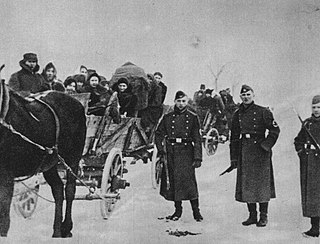 W
WBelzec was a Nazi German extermination camp built by the SS for the purpose of implementing the secretive Operation Reinhard, the plan to eradicate Polish Jewry, a key part of the "Final Solution" which entailed the murder of some 6 million Jews in the Holocaust. The camp operated from 17 March 1942 to the end of June 1943. It was situated about 500 m (1,600 ft) south of the local railroad station of Bełżec, in the new Lublin District of the General Government territory of German-occupied Poland. The burning of exhumed corpses on five open-air grids and bone crushing continued until March 1943.
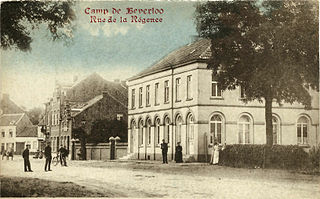 W
WBeverloo Camp was a military installation at Leopoldsburg, Belgium; 70 km southeast of Antwerp.
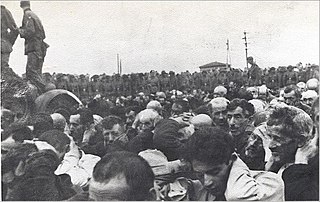 W
WThe Białystok Ghetto was a Nazi ghetto set up by the German SS between July 26 and early August 1941 in the newly formed District of Bialystok within occupied Poland. About 50,000 Jews from the vicinity of Białystok and the surrounding region were confined into a small area of the city, which was turned into the district's capital. The ghetto was split in two by the Biała River running through it. Most inmates were put to work in the slave-labor enterprises for the German war effort, primarily in large textile, shoe and chemical companies operating inside and outside its boundaries. The ghetto was liquidated in November 1943. Its inhabitants were transported in Holocaust trains to the Majdanek concentration camp and Treblinka extermination camps. Only a few hundred survived the war, either by hiding in the Polish sector of the city, escape following the Bialystok Ghetto Uprising, or by surviving the camps.
 W
WThe V-2 missile launch site, Blizna was the site of a World War II German V-2 missile firing range. Today there is a small museum located in the Park Historyczny Blizna in Blizna, Poland. After the RAF strategic bombing of the V-2 rocket launch site in Peenemünde, Germany, in August 1943, some of the test and launch facilities were relocated to Blizna in November 1943. The first of 139 V-2 launches was carried out from the Blizna launch site on 5 November 1943.
 W
WBronna Góra is the name of a secluded area in present-day Belarus where mass killings of Polish Jews were carried out by Nazi Germany during World War II. The location was part of the eastern half of occupied Poland, which had been invaded by the Soviet Union in 1939 in agreement with Germany, and two years later captured by the Wehrmacht in Operation Barbarossa. It is estimated that from May 1942 until November of that year, during the most deadly phase of the Holocaust in Poland, some 50,000 Jews were murdered at Bronna Góra forest in death pits. The victims were transported there in Holocaust trains from Nazi ghettos, including from the Brześć Ghetto and the Pińsk Ghetto, and from the ghettos in the surrounding area, as well as from Reichskommissariat Ostland.
 W
WThe Brześć Ghetto or the Ghetto in Brest on the Bug, also: Brześć nad Bugiem Ghetto, and Brest-Litovsk Ghetto was a Nazi ghetto created in occupied Western Belarus in December 1941, six months after the German troops had invaded the Soviet Union in June 1941. Less than a year after the creation of the ghetto, around October 15–18, 1942, most of approximately 20,000 Jewish inhabitants of Brest (Brześć) were murdered; over 5,000 were executed locally at the Brest Fortress on the orders of Karl Eberhard Schöngarth; the rest in the secluded forest of the Bronna Góra extermination site, sent there aboard Holocaust trains under the guise of 'resettlement'.
 W
WBrzesko Ghetto was a Nazi ghetto during World War II in occupied Poland. The ghetto was created by the Third Reich in 1941 in the Polish town of Brzesko located in the Kraków District about 40 miles from Kraków. The ghetto was open when it was first created. In 1942, walls were put up and the ghetto became a closed ghetto. An estimated 4,000 Jewish people lived there but another 2,000 moved there by 1942, many arriving from Kraków and the surrounding area. The Jewish people living within Brzesko were sent to the Bełżec extermination camp and Auschwitz extermination camp. After the exterminations, the camp was closed end of 1942.
 W
WThe Battle of the Bzura was the largest battle of the 1939 German invasion of Poland, fought between 9 and 19 September 1939, between Polish and German forces. It began as a Polish counter-offensive, but the Germans outflanked the Polish forces and took all of western Poland.
 W
WComiso Airport "Pio La Torre", also known as Vincenzo Magliocco Airport, is located in the Sicilian town of Comiso in the Ragusa province. The airport serves Comiso, Ragusa, Vittoria and Gela. It changed from military to civil use during 2005–2008. The airport was opened to commercial and general aviation 30 May 2013.
 W
WThe Crimea Campaign was an eight-month-long campaign by Axis forces to conquer the Crimea Peninsula, and was the scene of some of the bloodiest battles on the Eastern Front during World War II. The German, Romanian, and defending Soviet troops suffered heavy casualties as the Axis forces tried to advance through the Isthmus of Perekop linking the Crimean peninsula to the mainland at Perekop, from summer of 1941 through to the first half of 1942.
 W
WThe Częstochowa massacre, also known as the Bloody Monday, was committed by the German Wehrmacht forces beginning on the 4th day of World War II in the Polish city of Częstochowa, between 4 and 6 September 1939. The shootings, beatings and plunder, continued for three days in more than a dozen separate locations around the city. Approximately 1,140 Polish civilians, were murdered.
 W
WDora I is a former German submarine base and submarine pen or bunker built in Trondheim, Norway. Construction of the bunker was undertaken during the Second World War. Nearby is the uncompleted Dora II. Trondheim was traditionally referred to as Drontheim in German, and the name DORA is the letter "D" in the German phonetic alphabet.
 W
WDora II is an unfinished German submarine base and submarine pen or bunker in Trondheim, Norway, which is next to Dora I. Construction of the bunker was undertaken during the Second World War, but the complex was never finished unlike Dora I. Trondheim was traditionally referred to as Drontheim in German, and the name DORA is the letter "D" in the German phonetic alphabet.
 W
WDrobytsky Yar is a ravine in Kharkiv, Ukraine. In December 1941, Nazi troops invading the Soviet Union began killing local residents over the following year. At the end of this period, some 16,000 people, mainly Jews were killed. Notably on 15 December 1941, when the temperature was −15 °C (5 °F), around 15,000 Jews were shot. Children were thrown into pits alive, to save bullets, in the expectation that they would quickly freeze to death.
 W
WThe Führerhauptquartier Wasserburg, also known simply as "Wasserburg", was a bunker facility built by the Organization Todt as a front-line Führer Headquarters for Adolf Hitler during the Second World War about four kilometers north-west of Pleskau in the Soviet Union, on a loop of the Welikaja River.
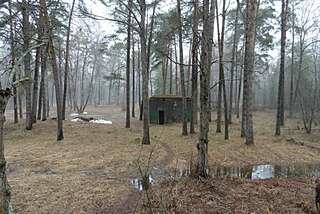 W
WThe Führerhauptquartier Bärenhöhle was a bunker facility built by the German organization Todt, which was built during the Second World War near Smolensk in the Soviet Union.
 W
WFührerhauptquartier Tannenberg was a Führer Headquarters built in 1939 for use as a military command and control facility by Adolf Hitler. It was located near Freudenstadt and Hitler stayed there for a week in 1940 while inspecting the fortresses that formed the Maginot Line.
 W
WThe Gaugefechtsstand Wien was a World War II subterranean command bunker situated in the densely forested Wienerwald western parts of Ottakring, the 16th district of Vienna. Commonly known as the Schirach-Bunker, the facilities were constructed between 1942 and 1945 as a massive underground extension to barracks that had been established in 1940.
 W
WGrønsvik coastal artillery battery at Helgeland in Norway, was a German army coastal artillery battery, built between 1942 and 1945 as one of ten coastal batteries in Artillery group Sandnessjöen. The coastal battery is today a museum whose purpose is to show the public that the Atlantic Wall in Norway was a lot more than the big naval batteries one can find scattered along the coast. Out of a total of 280 coastal batteries at the end of the war, 210 were army batteries armed with army guns and manned by army personnel and only 70 were naval batteries.
 W
WHohlgangsanlage are a number of tunnels constructed in Jersey by occupying German forces during the occupation of Jersey. The Germans intended these bunkers to protect troops and equipment from aerial bombing and to act as fortifications in their own right.
 W
WImielin is a town in Silesia in southern Poland, near Katowice. Borders on the Upper Silesian Metropolitan Union – metropolis with the population of 2 million. It is located in the Silesian Highlands. The population of the town is 9,175 (2019).
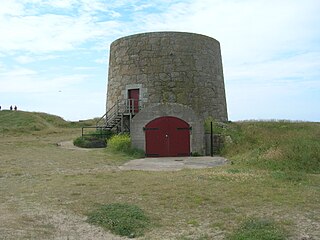 W
WLewis Tower, Jersey, is a Martello tower that the British erected in 1835 in St Ouen's Bay. The tower was named after Colonel Griffith Lewis, who commanded the Royal Engineers in Jersey from December 1830 to January 1836.
 W
WMajdanek was a Nazi concentration and extermination camp built and operated by the SS on the outskirts of the city of Lublin during the German occupation of Poland in World War II. It had seven gas chambers, two wooden gallows, and some 227 structures in all, placing it among the largest of Nazi-run concentration camps. Although initially intended for forced labor rather than extermination, the camp was used to kill people on an industrial scale during Operation Reinhard, the German plan to murder all Jews within their own General Government territory of Poland. The camp, which operated from October 1, 1941, until July 22, 1944, was captured nearly intact, because the rapid advance of the Soviet Red Army during Operation Bagration prevented the SS from destroying most of its infrastructure, and the inept Deputy Camp Commandant Anton Thernes failed in his task of removing incriminating evidence of war crimes.
 W
WThe Majdanek State Museum is a memorial museum and education centre founded in the fall of 1944 on the grounds of the Nazi Germany Majdanek death camp located in Lublin, Poland. It was the first museum of its kind in the world, devoted entirely to the memory of atrocities committed in the network of slave-labor camps and subcamps of KL Lublin during World War II. The museum performs several tasks including scholarly research into the Holocaust in Poland. It houses a permanent collection of rare artifacts, archival photographs, and testimony.
 W
WThe Sobibór Museum or the Museum of the Former Sobibór Nazi Death Camp, is a Polish state-owned museum devoted to memorializing the victims and atrocities committed at the former Sobibor extermination camp, located on the outskirts of Sobibór near Lublin. The Nazi German death camp was set up in occupied Poland during World War II, as part of the Jewish extermination program known as the Operation Reinhard, which marked the most deadly phase of the Holocaust in Poland. The camp was run by the SS Sonderkommando Sobibor, initially commanded by Franz Stangl. The number of Jews from Poland and elsewhere who were gassed and cremated there between April 1942 and October 14, 1943 is estimated at 250,000; possibly more, including those who were transported from other Reich-occupied countries.
 W
WMaly Trostenets is a village near Minsk in Belarus, formerly the Byelorussian Soviet Socialist Republic. During Nazi Germany's occupation of the area during World War II, the village became the location of a Nazi extermination site.
 W
WMittelwerk was a German World War II factory built underground in the Kohnstein to avoid Allied bombing. It used slave labor from the Mittelbau-Dora concentration camp to produce V-2 ballistic missiles, V-1 flying bombs, and other weapons.
 W
WPeenemünde Airfield is an airfield along the Baltic Sea north of Peenemünde, Germany. Today round trips in light aircraft take place from Peenemünde Airfield. Bus tours are also available, on which one can visit the former shelters of the NVA and the remnants of the V-1 flying bomb facilities. Because of its long runway the airfield Peenemünde is also a location for flight schools.
 W
WThe Peenemünde Army Research Centre was founded in 1937 as one of five military proving grounds under the German Army Weapons Office (Heereswaffenamt). Several German guided missiles and rockets of World War II were developed by the HVP, including the V-2 rocket. The works were attacked by the British in Operation Crossbow from August 1943, before falling to the Soviets in May 1945.
 W
WLa Pointe du Hoc is a promontory with a 100-foot (30 m) cliff overlooking the English Channel on the northwestern coast of Normandy in the Calvados department, France.
 W
WThe Festungsfront Oder-Warthe-Bogen, also called the Festung im Oder-Warthe-Bogen or Ostwall, and in Polish the Międzyrzecki Rejon Umocniony, MRU, was a fortified military defence line of Nazi Germany between the Oder and Warta rivers, near Międzyrzecz. The part around Międzyrzecz (Meseritz) has been colloquially referred to as the Regenwurmlager. Built in 1934–44, it was the most technologically advanced fortification system of Nazi Germany, and remains one of the largest and the most interesting systems of this type in the world today. It consists of around 100 concrete defence structures partially interconnected by a network of tunnels. Some of the forts and tunnels are available for visiting.
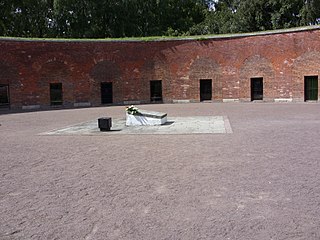 W
WThe Rotunda Zamość or the Museum of Martyrdom of the Zamość region - Rotunda, is a Polish museum devoted to remembering the atrocities committed at the former Rotunda Zamość Nazi German camp located in Zamość near Lublin. The Nazi German Gestapo camp was set up in occupied Poland during World War II, as part of the Polish extermination program known as the German AB-Aktion in Poland, Ethnic cleansing of Zamojszczyzna by Nazi Germany....
 W
WThe Rovno Ghetto was a World War II Nazi ghetto established in December 1941 in the city of Rovno, western Ukraine, in the territory of German-administered Reichskommissariat Ukraine. On 6 November 1941, about 21,000 Jews were massacred by Einsatzgruppe C and their Ukrainian collaborators. The remaining Jews were imprisoned in the ghetto. In July 1942, all remaining 5,000 Jews were trucked to a stone quarry near Kostopol and murdered there.
 W
WSaint-Inglevert Airfield is a general aviation airfield at Saint-Inglevert, Pas-de-Calais, France. In the First World War an airfield was established near Saint-Inglevert by the Royal Flying Corps, later passing to the Royal Air Force on formation and thus becoming RAF Saint Inglevert.
 W
WSambor Ghetto was a Nazi ghetto established in March 1942 by the SS in Sambir, Western Ukraine. In the interwar period, the town (Sambor) was part of the Second Polish Republic. In 1941, the Germans captured the town at the beginning of Operation Barbarossa. According to the Polish census of 1931, Jews constituted nearly 29 percent of the town's inhabitants, most of whom were murdered during the Holocaust. Sambor (Sambir) is not to be confused with the much smaller Old Sambor located close-by, although their Jewish history is inextricably linked together.
 W
WThe "second Ruhr" was a World War II area that included the "southern regions of Germany, the plateau of Bohemia, and Silesia" where Nazi Germany military production was dispersed away from Allied bomber bases in England. After Allied Operation Pointblank bombing of German aircraft facilities had begun, Nazi Germany dispersed the 27 larger aircraft works across 729 medium and very small plants, and oil production was also dispersed. However, by October 1943, long-range bombers could reach the area.
 W
WSobibor was an extermination camp built and operated by Nazi Germany as part of Operation Reinhard. It was located in the forest near the village of Sobibór in the General Government region of German-occupied Poland.
 W
WTheStreckelsberg is an approximately 58 metre high coastal cliff on the island of Usedom in North Germany. After the Golm and the Kückelsberg, the Streckelsberg is the third highest elevation on the island. The Streckelsberg is located half a kilometre southeast of the former fishing village and present-day seaside resort of Koserow directly on the Baltic Sea shore. To the southeast is the village of Kölpinsee; the B 111 federal road and Usedomer Bäderbahn railway run past the hill to the southwest.
 W
WSucha Dolna is a village in the administrative district of Gmina Wartkowice, within Poddębice County, Łódź Voivodeship, in central Poland. It lies approximately 6 kilometres (4 mi) east of Wartkowice, 14 km (9 mi) north-east of Poddębice, and 35 km (22 mi) north-west of the regional capital Łódź.
 W
WSyrets was a Nazi concentration camp established in 1942 in Kiev's western neighborhood of Syrets, part of Kiev since 1799. The toponym was derived from a local small river. Some 327 inmates of the KZ Syrets were forced to remove all traces of mass murder at Babi Yar.
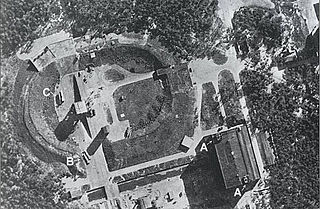 W
WTest Stand VII was the principal V-2 rocket testing facility at Peenemünde Airfield and was capable of static firing of rocket motors up to 200 tons thrust. Notable events at the site include the first successful V-2 launch on 3 October 1942, visits by German military leaders, and Allied reconnaissance overflights and bombing.
 W
WThe Todt Battery, also known as Batterie Todt, was a battery of coastal artillery built by the Nazi Germany in World War II, located in the hamlet of Haringzelles, Audinghen, near Cape Gris-Nez, Pas de Calais, France.
 W
WTreblinka was an extermination camp, built and operated by Nazi Germany in occupied Poland during World War II. It was in a forest north-east of Warsaw, 4 kilometres (2.5 mi) south of the village of Treblinka in what is now the Masovian Voivodeship. The camp operated between 23 July 1942 and 19 October 1943 as part of Operation Reinhard, the deadliest phase of the Final Solution. During this time, it is estimated that between 700,000 and 900,000 Jews were killed in its gas chambers, along with 2,000 Romani people. More Jews were killed at Treblinka than at any other Nazi extermination camp apart from Auschwitz-Birkenau.
 W
WIn order to carry out the planned V-1 "flying bomb" attacks on the United Kingdom, Germany built a number of military installations including launching sites and depots. Some of the installations were huge concrete fortifications.
 W
WV-2 rocket facilities were military installations associated with Nazi Germany's V-2 SRBM ballistic missile, including bunkers and small launch pads which were never operationally used.
 W
WFührerhauptquartier Werwolf was the codename used for one of Adolf Hitler's World War II Eastern Front military headquarters located in a pine forest about 12 kilometres north of Vinnytsia, in Ukraine, which was used between 1942 and 1943. It was one of a number of Führer Headquarters throughout Europe, and the most easterly ever used by Hitler in person.
 W
WWieruszów is a town with 8,639 inhabitants (2016). Situated in the southwestern part of Łódź Voivodeship, From 1975–1998, it was part of Kalisz Voivodeship. The town is situated along the Prosna river. The biggest attraction is the Church and Monastery popauliński of 1676 in its limits, located on the Prosna, the church of St. Nicholas. Spirit of the façade with two towers and chapels on the sides, forming a kind of transept. Inside the church, deserves special attention, nine baroque altars and choir stalls from 1682, with paintings on zapieckach. The choir is a portrait of Bernard Wierusz - the first owner and founder of the church Wieruszów. In 1673, Augustine's father died here Kordecki, a heroic defender of Jasna Góra during the Swedish invasion, and in 1973, during the celebration of the 300th anniversary of his death diagonal, the church was graced by the presence of Cardinal Karol Wojtyła - the future Pope John Paul II and Cardinal Stefan Wyszyński.
 W
WThe Wolf's Lair was Adolf Hitler's first Eastern Front military headquarters in World War II. The complex, which became one of several Führerhauptquartiere in various parts of Central and Eastern Europe, was built for the start of Operation Barbarossa—the invasion of the Soviet Union—in 1941. It was constructed by Organisation Todt.
 W
WFührerhauptquartier Wolfsschlucht I was the codename for one of Adolf Hitler's military headquarters, located in a farmhouse of the Belgian village of Brûly-de-Pesche, in the municipality of Couvin, close to the French border. It was occupied by Hitler between 6–24 June 1940 while awaiting the conclusion of the Battle of France.
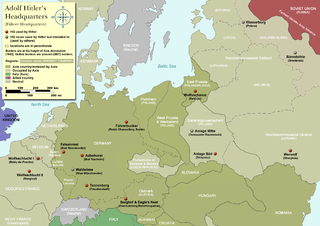 W
WFührerhauptquartier Wolfsschlucht II or W2 was the codename used for one of Adolf Hitler's World War II Western Front military headquarters located in Margival, 10 km northeast of Soissons in the department of Aisne in France. It was one of many Führer Headquarters throughout Europe but was used only once by Adolf Hitler, June 16 and 17, 1944 for a meeting with Field Marshals Erwin Rommel and Gerd von Rundstedt about the Normandy Front.